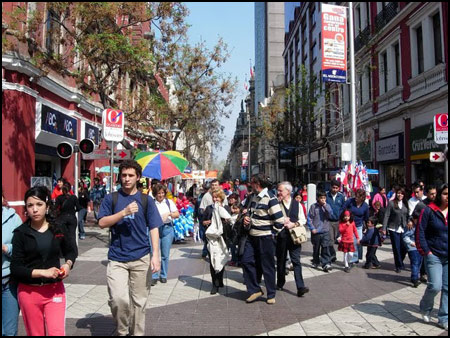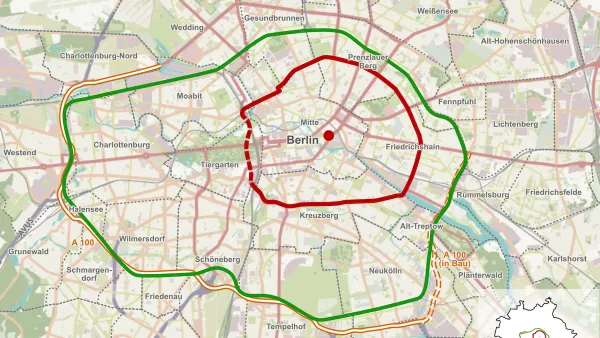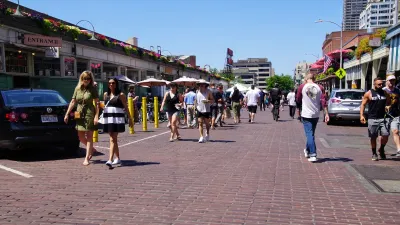It will take a long time for the US to embrace pedestrians, bicycling, and electric carts as substitutes for cars in our communities. And yet an inevitable change is coming that will significantly increase environmental quality, and restore real community and economic viability. Changing legislation, master planning, and the development of car-reduced and car-free communities will move us forward, writes Greg Ramsey.
In the last 60 years we have gone from people-centric communities to car-centric lifestyles. We no longer thrive in community-wise American cities, towns and farms, but rather commute to a series of single use destinations via roads and highway systems, fragmenting community and ecology. We are displaced to malls, office parks, big box stores and suburbs, to the top of a mountain, or across the country. We have surrounded ourselves with a landscape of "going" with no place left "to be".
Going somewhere has become more important than being somewhere. The old-timers used to say "where you going?" and "what's your hurry?" Every pretext has been used for going: better career opportunities, better prices, more options, and even friction with the neighbors. As a result, we have paid a heavy price. Today the earth is being turned upside down for the going: developing countries are installing interstate highway systems where only effective train infrastructure existed, effectively cutting off endangered species migratory routes forever; low-income, non-car owners are suffering the indignity and peril of walking across five-lane highways with their babies in tow; our children and elderly are languishing from a loss of freedom, mobility and true community.

The negative impacts of car-centric planning are immeasurable. Americans spend more on cars than third-world citizens spend on their entire budgets. The average American household expends 30-50% of its energy on car trips, and approximately 40,000 people are killed in auto accidents every year, with a disproportionate number of them being teenagers. Children and the elderly are stranded and lonely without access to our car-dominated culture, while "family" has become an insular experience, and now usually means only immediate family members. Roads and highways have not only fragmented the delicate balance of the eco-system of our planet, but are responsible for the elimination of 90% of historic American pedestrian connectivity.
Cars are ultimately extremely inefficient. They are designed to drive across the country at a blurring speed not allowing the occupants to appreciate or explore the area they travel – they are shut off from community from the point of departure until they reach their destination. It has been suggested that the solution to making cars "ecological" is running them on renewable energy. Nothing could be further from the truth. The impact of cars (high speed personal mobility) on our already fragmented communities and natural spaces would be exponentially increased.
Imaging Car-Free Communities
How do we reverse these trends and instead move towards car-reduced and car-free communities where woodlands, gardens, ponds, farms, delectable courtyards and workplaces are all within walking distance? Where a largely pedestrian lifestyle is like a healing salve inviting community cohesion and reconnection to nature. Where timeless buildings and nature fuse. Where young and old come together day-to-day and season-to-season. Where "down-time" can mean sitting beside a fountain with infusions of jasmine and the droning of bees, while a tot plays in the sunlight. Where dignity is restored to the movement of a "pedestrian pace". And where pedestrian spaces beckon activities, setting the stage for meaning and history, anchoring who we are as individuals, as a community and as a culture.
Car-Free Communities - A Planning Model
Our task is nothing less than calming global human habitation to a pedestrian pace. Pedestrians, bicycles and micro-vehicles that travel at 20 mph or less complement communities and nature well. They invite social interaction and drastically reduce the capacity for fragmenting our open spaces and bio-diversity. Fast movement is then left to efficient public transit linking our cities, towns, villages and hamlets.
Car-reduced and car-free community planning can be applied to new or existing communities at any scale, from neighborhood, hamlet and village, to town and city. It will be a slow conversion, but it will increase quality of life significantly each step of the way, as the use of cars is reduced. Planning for car-free communities at every scale will allow us to set up smart development (growth) opportunities for downtown conversions, infill neighborhoods, and convert existing neighborhoods. It will also enable our auto industries to shift focus to producing efficient electric micro-vehicles (possibly powered by photovoltaic arrays - a collection of cells that convert solar energy into electricity), and away from producing cars that are incompatible with community interaction and open space preservation.
There is a place for everyone in this transformation. A block resident can initiate car reduction on their street and even imagine the eventual conversion to a car-free street. Community advocates can retrofit their neighborhood. Developers can develop new neighborhoods, villages and hamlets, and politicians can pass supportive legislation. All of these initiatives will encourage compact, mixed-use, pedestrian-scale development integrated to green belts.
A percentage of the American population is ready and looking for car-reduced/free communities to live in, but the options are limited. Yet outside the typical US car-culture we can find a variety of examples of car-centered communities that are being converted to car-reduced or car-free communities. Existing American models for car-reduced/free communities include co-housing neighborhoods, eco-villages, downtown pedestrian districts, emerging electric cart communities and retirement communities with extensive community transportation. Historic American models include New Orleans and St. Augustine. In Europe entire towns are being converted to car-reduced/free communities by collecting cars at the outskirts of town, and allowing only foot and non-motorized traffic within. Downtown areas have been converted to pedestrian districts for decades. For example, Copenhagen has set a goal of reducing the impact of cars by converting streets into pedestrian thoroughfares, reducing traffic and parking, and turning parking lots into public squares.
The primary objectives to incorporate into a car reduced/free community are:
- Reduce car ownership and create cluster parking areas at the outskirt of the community. These cluster parking areas can then be converted over time to a place to house shared and rental vehicles. Greenfield development (building on land that has previously never been built on) will ultimately have to be bonded to insure financing for community transportation links (shuttle to town/city). Charging commensurate impact fees for new cars can pay for the community transportation infrastructure.
- Develop or convert existing streets to pedestrian, bike and electric cart/moped streets. Existing neighborhoods can start with the conversion of one street and then proceed to every other street, etc.
- Develop effective community and public transit links. Car reduced/free communities can only be as effective as their transit links. A community shuttle can be an effective way to connect the communities to more substantial public transportation.
- Development of pedestrian-proximity mixed-use communities, including residential, agricultural, energy production, wildlife habitats, workplaces, and community/civic buildings.
- Development of pedestrian scaled spaces and buildings that respond to privacy gradients, celebration of community, social interaction and links to nature.
Conversion will occur by increments while new communities can be designed as full pedestrian habitats. These communities will be devoid of highways and streets as we know them today.
Legislative steps towards creating a car reduced/ free society are:
- Reduce Ownership: Create tax incentives to invest in alternatives to cars and charge an impact fee for car ownership commensurate with the community and environmental impacts. Use these funds to initiate the pedestrian/bicycle/electric cart/moped infrastructure.
- Pedestrian Zoning: Create universal pedestrian-based zoning that only allows development within walking distance of support infrastructure linked by community and public transportation (walking distance should be a quarter-mile radius or a 5-10 minute walk, and a 1 mile bicycle radius).
- Conversion of Transportation Infrastructure: Systematically convert from a car infrastructure to a pedestrian/bicycle and electric cart infrastructure linked to community and public transit. A moratorium should be placed on the expansion of fast speed personal vehicle lanes and local impact fees placed on cars to initiate the conversion to slow and pedestrian zone infrastructures.
As we pioneer car-reduced/free communities, ratings can be developed to encourage performance such as the following:
- Platinum: No cars. Community is a total pedestrian, bicycle, and electric cart environment linked to community and public transit.
- Gold: 100% of houses have high speed personal vehicles located at the periphery of the community. In the interior community, the pedestrian, bicycle, and electric cart environment are linked to community and public transit.
- Silver: 50% of houses have cars located at the periphery of the community. In the interior community the pedestrian, bicycle, and electric cart environment are linked to community and public transit.
- Bronze: Houses have a maximum of 1 car per household located within the community. Additional cars are cluster parked at the perimeter of the community. The community streets are speed-calmed to 20 mph or less.
Long term goals include:
- State and National Constitutional amendment to allow use of gas tax to support pedestrian infrastructure and to promote pedestrian "zoning".
- United Nations – locate or form a committee to promote global car reduced/free pedestrian habitats.
Greg Ramsey is principal and chief designer of Village Habitat Design, LLC, based in Atlanta, Georgia. He has studied pedestrian village planning in Europe, the Middle East, and Far East, co-authored a conservation community design primer, and works internationally as a workshop leader, conservation community designer, and consultant. This article originally appeared on All Things Healing.

Planetizen Federal Action Tracker
A weekly monitor of how Trump’s orders and actions are impacting planners and planning in America.

Chicago’s Ghost Rails
Just beneath the surface of the modern city lie the remnants of its expansive early 20th-century streetcar system.

San Antonio and Austin are Fusing Into one Massive Megaregion
The region spanning the two central Texas cities is growing fast, posing challenges for local infrastructure and water supplies.

Since Zion's Shuttles Went Electric “The Smog is Gone”
Visitors to Zion National Park can enjoy the canyon via the nation’s first fully electric park shuttle system.

Trump Distributing DOT Safety Funds at 1/10 Rate of Biden
Funds for Safe Streets and other transportation safety and equity programs are being held up by administrative reviews and conflicts with the Trump administration’s priorities.

German Cities Subsidize Taxis for Women Amid Wave of Violence
Free or low-cost taxi rides can help women navigate cities more safely, but critics say the programs don't address the root causes of violence against women.
Urban Design for Planners 1: Software Tools
This six-course series explores essential urban design concepts using open source software and equips planners with the tools they need to participate fully in the urban design process.
Planning for Universal Design
Learn the tools for implementing Universal Design in planning regulations.
planning NEXT
Appalachian Highlands Housing Partners
Mpact (founded as Rail~Volution)
City of Camden Redevelopment Agency
City of Astoria
City of Portland
City of Laramie





























